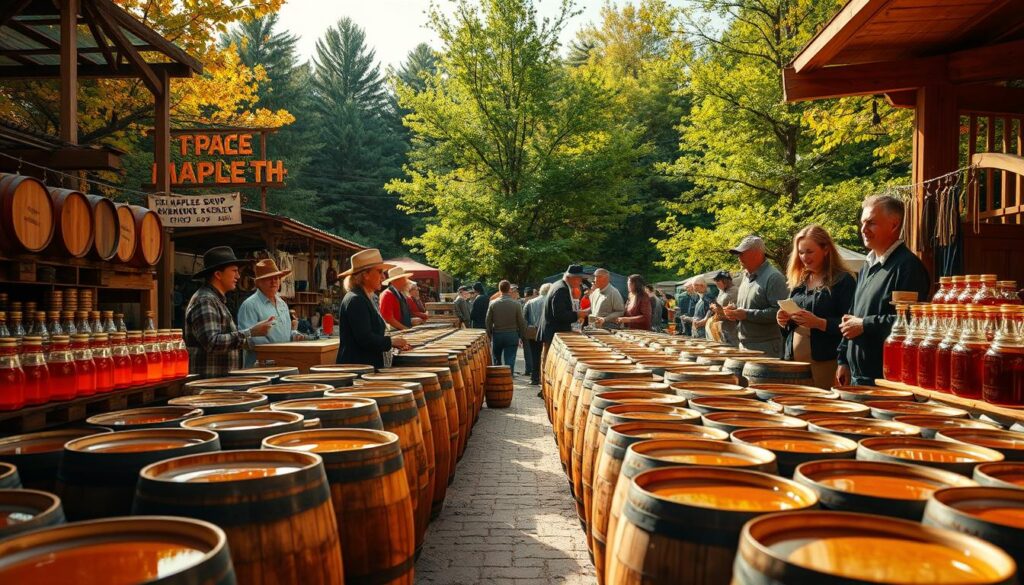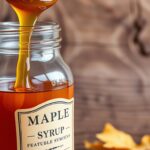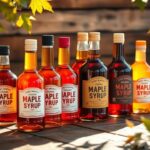The maple syrup market is changing fast, affecting how it’s made and sold worldwide. As more people want maple syrup, producers face new challenges and chances. They’re finding ways to keep up with these changes.
New methods in making maple syrup are making a big impact. These include better technology, changes in the market, and more focus on being green. Sugarmakers in North America are using new techniques to grow more syrup and meet what customers want.
The maple syrup market is complex, with many factors driving its growth. New tech, how people buy things, and caring for the environment are all playing a part. These factors are opening up new chances for producers to grow and succeed.
The world of maple syrup is changing fast, from old favorites like Quebec and Vermont to new places trying out making it. Producers are now focusing on making high-quality syrup that’s good for the planet and has unique tastes. This helps them stand out in a global market.
This detailed look will explore the latest in maple syrup trends. We’ll look at how production, the market, and how people buy syrup are changing. You’ll learn about the complex world of maple syrup and its importance in the economy.
We’ll examine new tech, green practices, global market shifts, and what customers want. Knowing these trends is key for anyone in the maple syrup business, investors, or fans. It helps them understand and move through this fast-changing market.
The Current State of Global Maple Syrup Production
The global maple syrup market has grown a lot in recent years. North America leads in maple syrup production. Canada is at the top, making up 71% of the world’s maple syrup.
The Canadian maple syrup industry is key to farming innovation and keeping the economy strong. Maple syrup making has moved from old ways to new tech. This tech makes the syrup better and more efficient.
North American Production Leadership
Quebec is the heart of maple syrup making, producing huge amounts that affect the global market. Important facts include:
- Over 11,000 maple syrup producers in Canada
- Approximately 37 million gallons of syrup produced annually
- Sophisticated tapping and collection technologies
Key Production Regions and Output
Maple syrup is made in several important areas, each adding its own value:
- Quebec: Primary production center
- Ontario: Significant secondary producer
- New Brunswick: Emerging maple syrup region
- Vermont (USA): Important North American contributor
Production Technology Advancements
Modern maple syrup making uses the latest tech to get better results. Precision tapping systems and new sap collection ways have changed old methods. They help make more syrup with less harm to the environment.
New tech like digital monitoring and automated networks is changing maple syrup making. It makes the process more green and productive.
Market Growth and Economic Impact Analysis
The maple syrup market has seen a big jump in recent years. This is thanks to more people wanting natural and handmade food. Experts say the demand for maple syrup will keep growing, with North America leading the way.
Several economic factors are helping the market grow. These include:
- Rising consumer awareness about natural sweeteners
- Expanding culinary applications beyond traditional uses
- Growing health-conscious consumer segments
- Increased international market penetration
Studies show the maple syrup industry is a big help to rural economies. Both small and big producers make a lot of money. This supports local communities and creates jobs.
| Market Segment | Economic Contribution | Growth Projection |
|---|---|---|
| Domestic Production | $500 Million | 7.2% Annual Growth |
| Export Markets | $250 Million | 9.5% Annual Growth |
| Specialty Products | $125 Million | 12.3% Annual Growth |
The maple syrup market is very strong and has a lot of room to grow. Investing in new production and marketing will help it keep growing and innovating.
“The maple syrup market represents a unique intersection of traditional agriculture and modern consumer preferences,” says industry expert Michael Thompson.
Understanding Maple Syrup Industry Trends in 2024
The maple syrup industry is changing fast. It’s all about new tastes and tech. Let’s look at what’s new in 2024 and how it’s changing the game for everyone.
Consumer Behavior Shifts
People’s tastes in maple syrup are changing. They want:
- Organic and locally-sourced maple syrup products
- Transparent production processes
- Sustainable and environmentally friendly options
- Unique flavor profiles and artisanal varieties
Digital Marketing Impact
Digital tools are changing how maple syrup is marketed. Small-scale producers are using social media to share their stories. Instagram, YouTube, and TikTok help show maple syrup’s journey from forest to table.
Supply Chain Evolution
The maple syrup industry is updating its supply chain. Producers are focusing on:
- Advanced tracking technologies
- Direct-to-consumer sales channels
- Improved inventory management systems
- Resilient distribution networks
These changes help maple syrup stay relevant. They meet today’s consumer needs while keeping its traditional charm.
Canadian Maple Syrup Industry Leadership
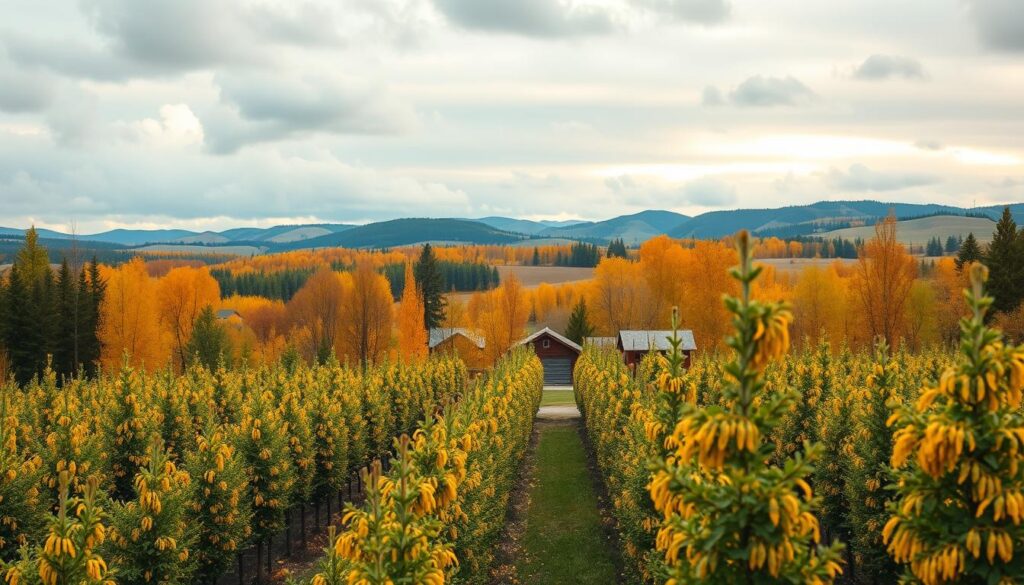
The Canadian maple syrup industry is a global leader. It dominates markets with its high quality and rich history. Quebec is at the forefront, producing about 72% of the world’s maple syrup. This makes Canada the top player in this sweet sector.
Several factors make Canada a leader in maple syrup production:
- Extensive maple forest networks spanning multiple provinces
- Generations of specialized maple syrup production expertise
- Advanced harvesting and processing technologies
- Strict quality control mechanisms
The Federation of Quebec Maple Syrup Producers is key to maintaining standards. Their strategic management ensures consistent quality and helps regulate market dynamics. This prevents price swings and supports sustainable production.
Canada’s maple syrup industry has a big economic impact, with over $500 million in annual revenue. The country’s focus on innovation and environmental care keeps it at the top. This makes Canadian maple syrup a top choice around the world.
Canadian maple syrup production is more than farming—it’s a national tradition that connects families through generations.
Price Fluctuations and Market Dynamics
The maple syrup market has complex pricing that fascinates both producers and consumers. To understand these changes, we must explore the world of maple syrup prices and market mechanisms.
Several key factors influence maple syrup prices, shaping a unique economic scene:
- Weather conditions affecting maple tree sap production
- Global supply and demand shifts
- Strategic reserves maintained by producers
- International trade patterns
Supply and Demand Factors
The maple syrup market balances production and consumer needs carefully. Climate changes can greatly affect syrup yields, leading to price swings. Sugarmakers face the challenge of stable production despite these changes.
Global Price Trends
Recent data shows interesting trends in maple syrup prices. North American producers, like those in Quebec, are key in setting global prices. The strategic maple syrup reserve helps keep prices stable by managing supply and demand.
Market Stabilization Efforts
Producers have come up with smart ways to handle market volatility. These include:
- Creating centralized marketing boards
- Establishing quality control mechanisms
- Developing international marketing collaborations
The maple syrup market is always changing. Producers and consumers are learning to adapt to new economic and environmental challenges.
Organic Maple Syrup Market Expansion
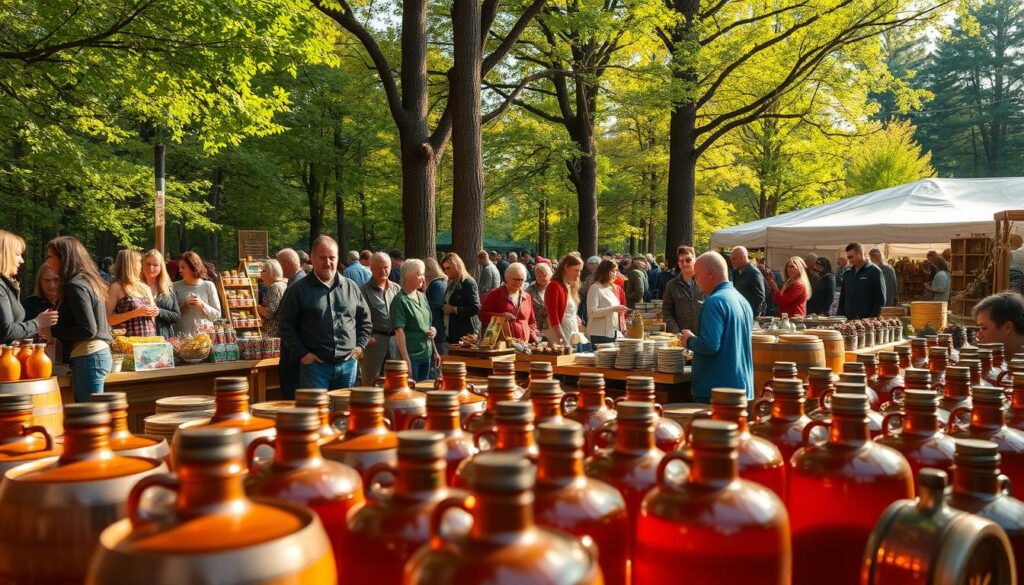
The organic maple syrup market is changing fast. More people want natural and sustainable food. They choose organic maple syrup for its quality and eco-friendliness.
Several factors are driving this demand:
- Growing awareness of organic food benefits
- Increased health-focused consumer preferences
- Environmental sustainability concerns
- Commitment to chemical-free production methods
Producers are keeping up by getting organic certifications. Organic certification means following strict environmental and production rules. This requires big investments in green farming.
The outlook for organic maple syrup is good. Small sugarmakers are making more money by going organic. They get higher prices and attract eco-aware buyers.
| Market Segment | Growth Projection |
|---|---|
| Organic Maple Syrup | 15-20% Annual Growth |
| Traditional Maple Syrup | 5-7% Annual Growth |
New tech and green farming methods help more producers join the organic market. This creates a strong system of eco-friendly food making.
Sustainability Practices in Maple Syrup Production
The maple syrup industry is changing fast. It’s moving towards sustainable production. This shift focuses on environmental conservation for long-term success and staying competitive.
Sugarmakers are changing how they care for the environment. They’re using new methods to protect forests and cut down on carbon emissions.
Environmental Conservation Methods
Today’s maple syrup makers are using key conservation strategies:
- Responsible forest management techniques
- Biodiversity preservation programs
- Selective tree tapping to minimize forest impact
- Wildlife habitat protection zones
“Sustainability isn’t just an option—it’s the future of maple syrup production,” says an industry expert.
Renewable Energy Integration
Maple Syrup Industry Trends highlight a big move towards renewable energy. Producers are adopting new technologies to reduce environmental harm:
- Solar-powered evaporation systems
- Energy-efficient processing equipment
- Biomass heating solutions
- Waste heat recovery mechanisms
These green practices not only save natural resources but also give producers a market edge.
International Trade and Export Patterns

The global maple syrup market has seen big changes in how it trades internationally. Canada leads, making up about 80% of the world’s maple syrup production and exports. The market is growing, with new export plans helping it spread across many continents.
Looking at export trends gives us interesting views of the industry’s global reach:
- North America leads in maple syrup trade
- Asia’s emerging markets are seeing more demand
- European countries are also growing their maple syrup use
Export volumes have shown strong resilience. The United States is a key player, helping Canada’s market lead. Now, the focus is on reaching more markets and building strong supply chains worldwide.
| Country | Export Volume (Metric Tons) | Market Share |
|---|---|---|
| Canada | 68,500 | 75% |
| United States | 15,200 | 17% |
| Other Countries | 6,300 | 8% |
The maple syrup market is always changing, thanks to new tech and green production methods. Producers are now focusing on value-added exports. They want to highlight quality, organic status, and special local flavors.
“The future of maple syrup trade lies in understanding global consumer preferences and maintaining exceptional product standards.” – Canadian Maple Syrup Export Association
Trade deals and lower tariffs have helped the market grow. This has opened doors for smaller producers to sell abroad. The maple syrup market shows it can adapt well to the complex world of global trade.
Consumer Preferences and Product Innovation
The maple syrup industry is changing fast. This is because of new tastes and creative products. People want to try different and exciting foods.
Producers are making new products to meet these needs. They’re not just making syrup for breakfast anymore. Now, they offer unique items that people love.
New Product Development Strategies
- Flavored maple syrups with unique profiles like lavender and bourbon
- Maple-based beverages including craft cocktails and energy drinks
- Specialty maple sugar and maple cream products
- Maple-infused condiments and gourmet cooking ingredients
Packaging Innovations
Packaging is getting a makeover too. It’s all about being green and easy to use. Eco-friendly and convenient packaging is now a big hit.
New packaging helps keep syrup fresh longer. It also makes it easier for people to enjoy maple syrup in new ways.
Climate Change Impact on Maple Syrup Production
Climate change is changing the maple syrup industry a lot. It’s making it hard to make maple syrup in North America. Weather that’s hard to predict is messing up how we harvest syrup. It’s also hurting the maple trees’ home.
Climate change affects maple syrup production in big ways:
- Shorter and less predictable sap collection seasons
- Increased temperature volatility disrupting tree health
- Shifts in maple tree habitats and growth patterns
- Reduced overall syrup yield
Maple Syrup Industry Trends show how producers are trying to adapt. They’re using new tech to keep up with the weather. This helps them make syrup even when it’s tough.
| Climate Factor | Impact on Maple Syrup Production |
|---|---|
| Rising Temperatures | Reduced sap flow and shorter harvesting windows |
| Extreme Weather Events | Potential damage to maple tree root systems |
| Precipitation Changes | Altered tree nutrition and stress levels |
Scientists are working on long-term fixes for maple syrup. Genetic research into more climate-resilient maple tree varieties is a big hope. It could help maple syrup stay strong against the weather.
Climate adaptation is no longer optional—it’s essential for the survival of maple syrup production.
Producers know they must act fast. They’re using new tech and science to fight climate change. This way, the maple syrup industry can stay strong.
Technology Integration in Modern Maple Syrup Processing
The maple syrup world is changing fast. New tech is making old ways better, adding speed and accuracy to this ancient art. Now, the Maple Syrup Industry Trends show how new tech is changing how syrup is made.
Digital tools are changing maple syrup making. Today’s makers use smart tools for every step, from collecting sap to finishing syrup.
Smart Manufacturing Solutions
Advanced tech is making syrup making better:
- Automated sap collection systems with real-time monitoring
- GPS-enabled forest mapping for optimal tree selection
- IoT-connected sensors tracking environmental conditions
- Cloud-based data management platforms
Quality Control Technologies
Now, keeping syrup quality high is key. New tech lets makers check syrup quality like never before.
| Technology | Purpose | Benefit |
|---|---|---|
| Near-Infrared Spectroscopy | Purity Analysis | Instant Chemical Composition Verification |
| Digital Refractometers | Sugar Content Measurement | Precise Sugar Concentration Tracking |
| Blockchain Traceability | Supply Chain Transparency | Complete Production History Tracking |
These new tools are not just making syrup better. They’re changing how we see, make, and enjoy maple syrup today.
Marketing Strategies and Brand Development
The maple syrup market has changed a lot. New marketing ideas are making it more engaging and well-known. Producers are telling stories that show the history and skill behind maple syrup.
Digital marketing is key to growing the demand for maple syrup. Brands use social media to share how they make syrup. They also talk about its health benefits and how it can be used in cooking.
- Storytelling that emphasizes traditional production techniques
- Social media campaigns highlighting maple syrup’s origin
- Influencer partnerships to reach broader audiences
- Transparent communication about sustainability practices
Successful brands are making real connections with people. They do more than just market their products. They focus on building a story around their syrup.
“Our maple syrup is more than a product—it’s a story of tradition, craftsmanship, and commitment to quality.” – Maple Producer Association
Some important marketing tactics in the maple syrup market are:
- Creating interactive online experiences
- Sharing knowledge about how maple syrup is made
- Showing off eco-friendly practices
- Introducing unique flavors and ways to use syrup
By using these new marketing ideas, maple syrup makers are reaching more people. They are building brands that appeal to today’s consumers.
Regulatory Environment and Quality Standards
The global maple syrup market has strict rules to keep products safe and of high quality. Producers must follow detailed certification processes and strict food safety rules. This helps them stay competitive in the international market.
Maple syrup production has to meet tough rules that change by region and country. These rules help protect consumers and keep the industry’s high standards.
International Certifications
Important international certifications are key for maple syrup quality:
- USDA Organic Certification
- International Maple Syrup Institute (IMSI) Standards
- Global Food Safety Initiative (GFSI) Compliance
- Fair Trade Certification
“Quality is not an act, it is a habit” – Aristotle
Food Safety Protocols
The maple syrup industry has strict food safety rules for every step of production. These rules ensure the product is safe and of good quality.
Important food safety steps include:
- Strict hygiene standards in collection and processing facilities
- Regular microbiological testing
- Traceability documentation
- Temperature-controlled storage and transportation
Emerging regulations continue to shape maple syrup production practices, focusing on transparency, sustainability, and quality in the global maple syrup market.
Conclusion
The maple syrup industry is at a thrilling point, blending old traditions with new ideas. Trends show a market that’s changing fast, thanks to tech, green efforts, and what people want. Producers in places like Quebec and Vermont are using smart tech and caring for the environment. This keeps the industry strong.
What people like to buy is changing the maple syrup market a lot. More people want organic syrup, new packaging, and online marketing. This makes maple syrup more than just a sweetener. It’s a high-quality product that’s becoming more popular worldwide.
The future of maple syrup will mix old ways with new tech. The industry will need to deal with climate change, use better quality checks, and make deals with other countries. This will help maple syrup keep growing. For both buyers and makers, the future looks sweet.
The maple syrup industry is very flexible as global markets change. It’s using the latest tech while keeping its cultural roots. This shows how the industry is strong, innovative, and cares for the earth.

